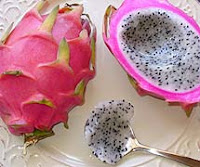 When I first laid eyes on a dragon fruit it was love at first sight! The blinding magenta skin with its lime green scales was enough for me, and then I cut it open to reveal the translucent white flesh, punctuated with black seeds and I thought — ‘giant kiwi fruit’.
When I first laid eyes on a dragon fruit it was love at first sight! The blinding magenta skin with its lime green scales was enough for me, and then I cut it open to reveal the translucent white flesh, punctuated with black seeds and I thought — ‘giant kiwi fruit’.
When I gently gouged out a big scoop of speckled goodness, it was like scooping sorbet and the taste was mild, slightly sweet and sour at the same time, refreshing and cool. Because of its’ bizarre look and feel, I was totally absorbed in the experience, like Alice in her wonderland of fantasy fruits.
Different varieties
A dragon fruit, also known as a strawberry pear or pithaya, is actually the fruit of a cactus. It originated in South America, but is now cultivated widely across both Americas, Australia and is Vietnam’s biggest export.
There are three main varieties; pink skin with white flesh; pink skin with red flesh; and yellow skinned with white flesh. In South Africa disappointingly, we only get the white fleshed variety.
To choose a ripe dragon fruit, ensure even, deep colouring of flesh, and leave it for up to a week in your fruit bowl before chilling it in the fridge the day before you eat it.
The red fleshed-dragon fruit is by far the most popular and widely grown because of its extra sweetness and alluring colour. In fact the biggest business of these odd cactus fruits is hybridisation to get the reddest and the sweetest variety. So far the introduction of such varieties as ‘red jaina’, ‘purple haze’ and ‘cosmic Charlie’, make it seem more like growing marijuana than a healthy fruit!
Another interesting fact about these otherworldly plants is that their spectacular flowers, (just one could be a wedding bouquet of its own) only bloom at night, allowing a very small window for self pollination and so fruits have not been naturally abundant, hence the rarity and healthy price. However, nowadays there are cacti farms that are cross pollinated by hand to ensure every flower produces fruit, resulting in an agricultural gold mine!
Myth about the dragon fruit
In ancient eastern legends when dragons still roamed the earth, man and beast would do battle for territory. A soldier sent to kill a dragon for his emperor would be aiming to bring back one thing — the prized dragon fruit.
When he thrust his sword into the dragon’s heart, the dragon would breathe out his last fire and also the dragon fruit. This fruit would then be presented to the emperor and the soldier would be revered. The tastiest flesh of the dragon was said to come from his tail, as this is where they believed his fire and fruit was breathed from deep inside his body.
It is said that the emperor’s taste for this delectable flesh is what caused the extinction of the illustrious dragon.
Grow your own?
You can even grow your own, by separating a couple of seeds from the flesh and planting it in a soil-filled pot, putting the whole thing into a clear plastic sandwich bag and watering it gingerly for two weeks. It needs sun and shelter. And voila!
Despite looking like alien time capsules, these fantastical fruits are really very good for you. They are very high in the antioxidant lycopene (the same found in tomatoes) which we know to fight heart disease, lower blood pressure and have anti-ageing properties. It is rich in fibre and vitamin C and A, has zero fat and is low in calories.
Traditional uses have been to brew the root, or brew the flower or my personal favourite — brew the fruit, which results in dragon fruit wine! It’s available mostly in Malaysia and the locals argue that it is indeed better than its grape counterpart.
Because of the sudden trend in this ‘new’ health food, juice companies are now using its beneficial extracts in their beverages, including the American brand Snapple. The marketing hype is soon set to rival with the goji berry and pomegranate as the next biggest super food!

Hi,
In which province in South Africa is this cultivated ?